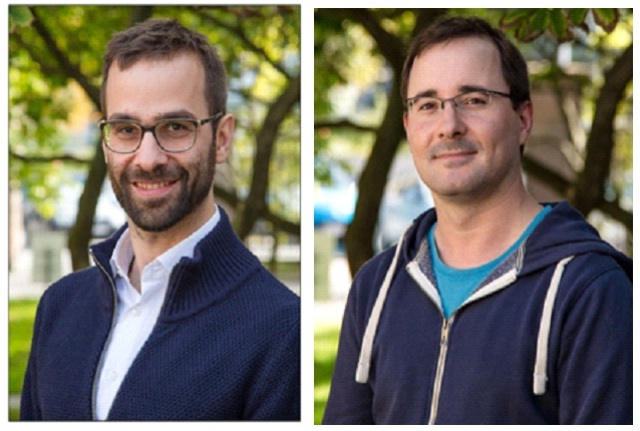Dec 19 2014
Two younger researchers from the Niels Bohr Institute, Albert Schliesser, Assistant Professor in Quantum Optics and Oliver Gressel, Assistant Professor in Astrophysics and Planetary Science has received grants totalling more than 21 million kroner from the European Research Council, ERC for research projects. The coveted ERC Starting Grants provide young talented researchers a unique opportunity to speed up an already promising research career.
 Albert Schliesser and Oliver Gressel
Albert Schliesser and Oliver Gressel
Albert Schliesser, Assistant Professor in Quantum Optics at the Niels Bohr Institute, University of Copenhagen, has received a grant of 1,495,073 Euros (11,128,000 kr.) for the project “Quantum Cavity Electro- and Opto-Mechanics”.
The research project aims to study the interactions between nanomechanical movement, lasers and microwaves on the quantum level and make them work together in entirely new ways. The goal is to develop new methods to process and transmit small signals between these different systems and thus reap the benefits of them all. For example, light can easily be transmitted over several hundred kilometers through optical fibers without significant loss – which is impossible for microwaves. The nanomechanical systems play a particularly important role because of their versatility and by using them properly, they can be strongly linked to fields from the entire electromagnetic spectrum from radio to optical frequencies.
“I want to explore how mechanical devices can function as a bridge between different quantum systems. This is generally not easy as mechanical systems are so strongly linked to our noisy, classical world. As a result, they typically distort any signal that is sent to them, especially if that signal is very small. But using new devices and protocols, we can circumvent this problem, which will allow us to use mechanical systems in new ways. In particular, there is great potential in being able to overcome the frequency gap between superconducting circuits for information processing and optical communication using photons. Generally, the systems we are studying here could function as a kind of test case for mechanical converters in hybrid systems,” explains Albert Schliesser.
The grant is for 5 years and the research group will include two PhD students and a postdoc.
Oliver Gressel, Assistant Professor in Astrophysics and Planetary Science at the Niels Bohr Institute, University of Copenhagen, has received a grant of 1,396,763 Euros (10,396,276 kr.) for his research project “First-principles global MHD disc simulations: Defining planet-forming environments in early solar systems”.
Stars and planets are formed in clouds of cold dust and gas. These clouds collapse due to gravity and become young protostars. However, not all of the dust and gas collapses into the protostar – some collects into a flattened disc and it is in this disc that the planets are formed. But what is the formation process?
“The aim of my research project is to create the most realistic computer simulations of protoplanetary discs of gas and dust, thus defining the environment that shapes the early development of planetary systems,” explains Oliver Gressel.
The dynamics, radiation and thermodynamic properties of these protoplanetary discs critically define the environment for embedded solids - that is the building blocks of planet formation. As the discs are relatively cold and dense, the ionisation state of the plasma disc is dominated by UV, X-ray and cosmic radiation. So far the theory has been that a vertically layered structure is formed with a turbulent magnetised surface and a non-magnetic midplane layer, a so-called ‘dead zone’.
“This classical ‘dead zone’ picture has now been turned on its head due to micro-physical effects that were previously ignored. Our understanding of the structure of the protoplanetary disc is about to undergo a dramatic shift and this research project is on the forefront of that development. Our ambitious simulations will produce virtual observations that will help interpreting real observations made with the ALMA telescopes,” explains Oliver Gressel.
His research project will run for 5 years and will lead to the hiring of two PhD students and two postdocs.